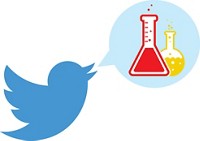Advertisement
Grab your lab coat. Let's get started
Welcome!
Welcome!
Create an account below to get 6 C&EN articles per month, receive newsletters and more - all free.
It seems this is your first time logging in online. Please enter the following information to continue.
As an ACS member you automatically get access to this site. All we need is few more details to create your reading experience.
Not you? Sign in with a different account.
Not you? Sign in with a different account.
ERROR 1
ERROR 1
ERROR 2
ERROR 2
ERROR 2
ERROR 2
ERROR 2
Password and Confirm password must match.
If you have an ACS member number, please enter it here so we can link this account to your membership. (optional)
ERROR 2
ACS values your privacy. By submitting your information, you are gaining access to C&EN and subscribing to our weekly newsletter. We use the information you provide to make your reading experience better, and we will never sell your data to third party members.
Education
How Slack-ing helps chemists manage their labs
A messaging app called Slack is helping academic research groups communicate more effectively
by Matt Davenport
July 18, 2016
| A version of this story appeared in
Volume 94, Issue 29
The Pros and Cons of Slack-ing in the Lab
To learn more about the benefits and shortcomings of Slack, C&EN chatted with some of Anne J. McNeil’s team members at the University of Michigan. Listen to our audio story featuring postdocs Gesine Veits and Chen Kong, along with special vocal appearances from members of C&EN’s own staff
.Founders of Silicon Valley start-ups dream about building fast-growing companies and workforces. It’s not something chemistry professors such as Anne J. McNeil usually think about for their labs, though.
McNeil had been leading a group of chemists developing new gels and polymers at the University of Michigan for seven years, when, in 2014, she won a Howard Hughes Medical Institute professorship. She earned the honor thanks to her proposal to develop an education program to engage high schoolers and young undergrads from diverse backgrounds with real chemistry research. To do this, she had to add a new division to her team.
“My group size doubled when I got the HHMI professor grant. Suddenly, I had this second research group working in a new area—education—on a different floor and office space,” McNeil says. “I was having a hard time staying on top of everything on both sides. Slack has changed all that.”
Slack is messaging software available for tablets, smartphones, and computers designed for teams and work groups. Slack creates a self-contained online chat room that’s exclusive to team members. Those members can then message one another directly or via public discussion channels organized by task, project, or topic. Teams at a variety of companies and agencies are using Slack, including Samsung, LinkedIn, the National Aeronautics & Space Administration, and even C&EN.
But academic chemists such as McNeil are also starting to use Slack to help manage their groups. Most of the scientists C&EN spoke with for this story agree that the program is helping their teams communicate faster and more effectively, but researchers are divided on how useful the platform truly is.
McNeil’s team finds it very handy, though. In a typical week, the team uses Slack to send about 400 messages and 70 files, including journal articles to read or conference posters to review, McNeil says. But why use Slack instead of e-mail?
For one, it shrinks the energy barrier of composing an e-mail. Trivial though that barrier may seem, it came up in every interview C&EN conducted for this story.
One thing contributing to the barrier is that there’s an expectation of some formality in e-mails that’s absent in a messaging app, researchers say. McNeil and her team can respond to Slack messages with one line, one word, or even a single emoji, which many agree would violate e-mail’s nebulous norms.
And there’s no need to cook up short, descriptive subject lines for Slack. Teams organize Slack chats into channels that let everyone know what’s being discussed. Users can subscribe to channels that are relevant to them, and thus, senders needn’t worry about forgetting to cc someone or accidentally adding someone they shouldn’t.
McNeil, for instance, has separate channels for the part of her group working on gels and the subgroup focused on education. There’s also a channel for random messages where students and postdocs can expect to see the occasional picture of McNeil’s adorable children.
Additionally, Slack simplifies searching for and finding specific messages, which can be maddening in long e-mail chains, McNeil adds. A member of C&EN’s advisory board, François-Xavier Coudert, agrees, but with a caveat.
His team at Chimie ParisTech studies the molecular interactions of fluids in porous media computationally and has been using the free version of Slack since January. Coudert remains unconvinced that it’s worth paying more than $6.00 per user per month to upgrade and lift the restrictions Slack’s free version puts on certain functions, including search.

Slack is most useful for small things, Coudert says, such as sharing tips for using a supercomputer or announcing that a server is down. But his group still relies on e-mail for the big things: exchanging manuscript revisions and planning research projects with collaborators.
Coudert says that Slack does encourage communication within the group, though, which is valuable for his multinational team. It helps keep everyone on the same page regardless of where they’re stationed, and it lets team members share stories from their homelands.
“Students post the latest scary animals found in Australia and weird news from Scotland,” Coudert says. “It’s a neat tool, but it’s not a game changer.”
Slack has, however, changed how T. Ben Britton supervises his group of materials scientists and engineers at Imperial College London. They’ve been using Slack since September, and the app makes it easier for members to contribute and access lab-related information, which helps democratize research, Britton says.
The platform is reminiscent of whiteboards Britton and his lab mates used when he was a student. They’d scrawl messages to let each other know when equipment was broken and which supplies needed to be ordered. Slack has replaced those boards and added some digital bonuses.
For example, two of Britton’s students recently traveled to a conference, and Britton felt some anxiety over not being in the room for their presentations. But the students got on Slack to share photos and updates, like an Instagram account shared exclusively with lab members. “Slack creates more connection without being more intrusive,” Britton says.
For Michigan’s McNeil, another benefit of Slack is the ability to prioritize her team, a thought she relayed to C&EN via e-mail. It’s tempting to see some irony in an e-mail about Slack, but the exchange underscores McNeil’s point: Slack is just for her team. E-mail is for everyone else, reporters included.
This separation lets McNeil focus on her team first when she has time, which is an increasingly rare commodity as she becomes more involved on campus. She can sneak in some Slack time discreetly during faculty meetings. And she can use it when she’s at home, although that has its drawbacks.
McNeil doesn’t check Slack at home while her kids are awake, and as a result, she’ll often catch up on messages between 10 PM and 1 AM, she says. “I do worry about the perception it gives.” Students may presume, for instance, that they’re expected to be working during the wee hours as well.
But, by and large, the group has embraced Slack, as has McNeil. “I love it,” she says. “I feel on top of things. I didn’t feel that way for a long time.”
App-sotively posilutely
Reporting on Slack got C&EN curious about other apps chemists are using to work more effectively. Here are some we heard about. Let us know about your favorite productivity app in the comments.
Dropbox: This service allows researchers to store, share, and access data on the web through apps available for tablets, smartphones, and computers. Dropbox has been a game changer for François-Xavier Coudert, a computational chemist at Chimie ParisTech and member of C&EN’s advisory board.
Overleaf: It’s still too soon to tell if Overleaf will be as useful as Dropbox for Coudert, but this online service has the potential. Overleaf lets collaborators easily edit equation-heavy manuscripts and offers templates for most chemistry journals, he says.
Howdy: Howdy is a free program that operates inside Slack and is “phenomenally handy,” says T. Ben Britton, a materials scientist at Imperial College London. Britton uses Howdy to automate weekly check-ins with staff and students: Howdy sends out a survey asking about progress and problems. It’s especially useful while Britton’s traveling.
Sortd: Anne J. McNeil is running a 21st-century digital lab at the University of Michigan. Group members record data in electronic lab notebooks from Biovia and use Mendeley to share and manage literature and citations. But McNeil is particularly excited about Sortd, an app that lets her better organize her to-do lists and Gmail inbox. “It is the best thing since sliced bread,” she says.





Join the conversation
Contact the reporter
Submit a Letter to the Editor for publication
Engage with us on Twitter